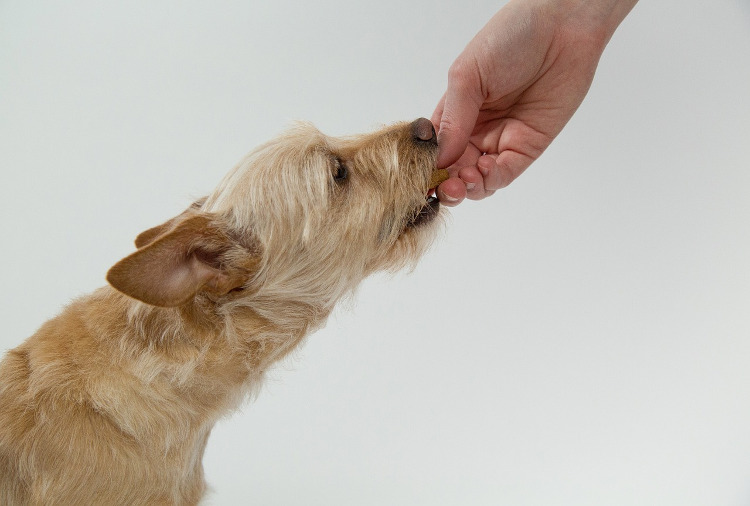![]()
As almost everyone has an opinion about food allergy in pets, there are many myths and misconceptions about food allergies in dogs. It is easy to form an opinion on something quite common, thus food allergy does fall prey to different opinions and beliefs.
The diagnosis, signs and treatment of a food allergic dog can vary based on individual experience, so it is only valid to have differing opinions. Following are some well-known facts about for allergies that are not based on experience and belief alone. These are facts based on documented scientific evidence that veterinary dermatologists often use to help determine how best an itchy, allergic, or food sensitive dog patient should be treated.
It is estimated that about 10% of dogs affected by itchy skin or persistent skin problems, severe enough to be presented to veterinary dermatologists, are affected by food allergies. A bigger proportion of dogs are usually diagnosed with environmental seasonal or non-seasonal allergies as well as flea allergy dermatitis (flea bite allergy). Such data indicates that while food allergy is a significant and relatively easily treated problem of our canine companions, other allergic causes should also be considered for dogs affected by itchy skin, infected ears or recurrent skin problems.
A food allergy is simply the individual dog’s immune system over-reacting to a normal dietary ingredient, thus causing adverse symptoms that may be skin-related with increased inflammation of the skin. It may also cause increased gastro-intestinal upset and signs such as increased bowel movements per day, vomiting, diarrhea, and so on. Common food allergens in dogs are documented to be the commonly fed proteins in diet such as beef, dairy products, chicken, lamb, wheat, and eggs, although an individual dog may be affected by any dietary ingredient acting as an allergen.
Rare dietary allergens can include practically any food ingredient you can think of, for example tomato, rice, or that milk bone your dog loves to get. No matter what the allergen, it is important to remember that the diet is not at fault (other dogs may eat the same diet and have no problems at all). It is the patient’s immune system that is hyper-reactive to the particular food they are allergic to.
Signs of a Potential Food Allergy
- Itching and scratching, including licking of paws, rubbing face on carpet, etc.
- Dandruff or excessively dry skin
- Excessively oily and greasy coat (a healthy coat is shiny, non-itchy, with supple skin)
- Chronic or recurrent ear infections
- Waxy build up in ears needing frequent cleaning
- Redness of the paws or skin at belly region
- General lethargy or irritability
- Eye infections and inflammation
- Gastrointestinal upset signs such as diarrhea, gas (flatulence), increased number of stools per day (1-2 bowel movements a day are considered normal), vomiting, soft stools, etc. A food allergy must be distinguished from other potential causes of these gastrointestinal signs.
Some Other Causes of Gastrointestinal Signs
- Parasites such as hook worms, round worms, etc.
- Viral infections of the gut
- Bacterial infections
- Pancreatitis
- Indiscriminate eating of things that are not meant to be eaten
Often gastrointestinal symptoms related to a food allergy will be noted with certain treats or on certain diets. It can sometimes be difficult to ascertain which part of the diet may be causing the signs without help from a veterinarian well versed in diagnosing allergies. For pets that have symptoms only on certain diets, food sensitivity is likely and can be indicative of a range of conditions that overlap such as irritable bowel syndrome, inflammatory bowel disease, malabsorption syndrome, food allergies, and so on. Your vet can help differentiate between these overlapping conditions and recommend diagnostic as well as treatment steps.
Diagnosis of a Food Allergy
There is no easy test to determine presence of a food allergy in your pet. A number of blood tests, a salivary swab test, and DNA tests are available through diagnostic laboratories and even directly to the pet owner through online advertising. However, these tests are not helpful in obtaining a clear answer on what foods your pet is allergic to.
These tests definitely don’t help you check if your pet is food allergic or not, i.e. there is no simple test to give you a ‘yes’ or ‘no’ answer when it comes to food allergies.
The gold standard and also the only available method that is reliable in diagnosing food allergies in pets is a well performed strict dietary elimination trial, based on your dog’s specific long term dietary history.
After pursuing a food trial for 2 months and assessing response to this change, a dietary provocation trial is pursued in order to help confirm or rule out presence of a food allergy. This process is called the dietary elimination trial followed by provocative dietary challenge.
There is no cookie cutter approach that helps pets with food allergy. Thus, veterinarians don’t simply pick the same diet to treat food allergy in all dogs that they see. Similarly, if your friend or neighbour’s dog did well on a certain food, there is no way to know if that food will also benefit your own dog the same way.
Careful review of long-term dietary history including previous diets, supplements, treats, and chew bones is required to come up with an appropriate dietary trial which will have the most likely chance of helping the dog. If effective, this diet also forms the treatment of the dog in question.
If the trial doesn’t help, further dermatology diagnostic work up on allergies can be pursued including environmental allergy testing and desensitization.
Some helpful indicators for presence of food allergy in dogs are:
- Presence of both skin-related and gastrointestinal symptoms
- Recurring skin or ear infection despite resolution with appropriate treatments
- Non-seasonal itchiness and skin infections
- Onset of allergies within first year of life
- Onset of allergies after 7 years of age
Dietary Elimination Trial – What Is A Hypoallergenic Diet?
There is no true “hypoallergenic diet” that will help all allergic pets. Humans with allergies may have differing allergies to food such as peanuts, milk, seafood, and avocados to name a few things. Similarly, different dogs will have differing allergies. When starting a dietary elimination trial, the focus should be on having a single protein diet that does not have added extra proteins.
The protein source should ideally be novel to your dog (new protein i.e. never have been eaten by the pet before) or should be hydrolyzed (protein molecules are small enough to minimize chance of an allergic reaction).
Veterinary prescription diets are processed in plants with thorough cleaning practices that are closely monitored so that contamination of such diets with other proteins doesn’t occur.
Studies have demonstrated that this amount of purity is not present in pet store bought foods, as extra non-labelled proteins may be present in pet store bought foods. This is a big reason why pet dermatologists and veterinarians usually recommend veterinary prescription diets to start a dietary elimination trial.
You may be able to manage your dog afterwards with an over-the-counter dog food, keeping in mind potential flare-ups if the food contains the allergen your dog is sensitive to. Under the supervision of your vet or vet dermatologist, such flare-ups would be easy to catch after having done a thorough initial work up.
“Allergy Diet” Myth
No diet is completely “hypoallergenic.” The closest you can get are the hydrolyzed diets purchased through your vet.
If you need to start a dietary elimination trial for a dog, consider the protein source and purity of the diet. The brand name, whether a diet is called “all natural” or “limited ingredient” or “hypoallergenic” etc. are marketing tactics that may not mean anything if the diet is not truly a single protein diet.
Also, there is no evidence that continually changing their diet ingredients prevents food allergies. Such an approach can limit diet choices to try and diagnose the allergy in the future, if needed.
What Foods are Associated with Most Allergies in Dogs? (h2)
The most common foods associated with your pet’s allergies are chicken, beef, dairy, lamb, wheat, soy, and eggs. Grains are a surprisingly uncommon problem in pets, with the occasional pet allergic to a specific grain or plant-sourced ingredient such as rice or tomato.
If you suspect your pet has a food allergy, talk to your vet to be sure you’re on the right track to properly diagnose it and treat it rather than getting stuck in a vicious cycle of dietary changes and allergic flares.
Creative Commons Attribution: Permission is granted to repost this article in its entirety with credit to VetDERM Clinic and a clickable link back to this page.

Dr. Jangi Bajwa is a Board certified veterinary dermatologist at VetDERM Clinic in Surrey BC. He is also the dermatology feature editor for Canadian Veterinary Journal. Dr. Bajwa’s special interests include otitis and allergic disease in pets; as well as helping improve quality of life of pets and their families.



 by
by